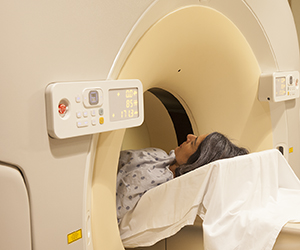CT Colonography (Virtual Colonoscopy)
A CT scan is a test that combines X-rays and computer scans. A CT colonography is used to view the inside of your lower digestive tract (colon and rectum). It can help screen for colon cancer and for small growths (polyps) in the colon that can become cancer. This test is sometimes called virtual colonoscopy. In some cases, this test may be done instead of a regular colonoscopy for colon cancer screening. Both tests require a bowel prep, but regular colonoscopy also requires sedation. No sedation is needed for CT colonography. But unlike regular colonoscopy, no biopsy or treatment can be done during the CT colonography. If a problem is found that needs further examination or treatment, a regular colonoscopy may be required.
Before the test
-
Tell your healthcare provider about any current or past health conditions.
-
Tell your healthcare provider what medicines you take. This includes vitamins, herbs, and over-the-counter medicines, such as aspirin. It also includes prescription medicines. You may need to stop taking certain medicines before the test.
-
Your kidney function may be tested. This is to be sure your kidneys are working well. If they are not, this test may not be safe for you.
-
For the test, your rectum and colon must be empty of stool. You will be given bowel prep instructions that will likely also include an agent to tag the bowel. Follow these carefully. For up to 48 hours before the test, you may need to restrict what you eat and drink. You will also need to take pills or drink a liquid to cleanse your bowel of stool.
-
Be sure to get to the facility on time. Bring your health insurance card. Leave your valuables at home. Also remove any metal piercings, such as a belly button ring, before leaving home. Metal interferes with X-rays.
-
At the hospital, you will be asked to sign a consent form. You will change into a hospital gown.
-
Follow any instructions given by your healthcare provider or the technologist.
At the testing site
For your safety, tell the technologist if you:
-
Are currently being treated for or have any form of colitis or diverticulitis. This includes Crohn’s disease or ulcerative colitis
-
Are pregnant or think you may be pregnant. The radiation from a CT scanner can harm an unborn child. If you think you may be pregnant, you should not have a CT colonography unless it is medically needed and there are no other options.
-
Ate or drank anything before the test
-
Have any known kidney problems
-
Had a past reaction to IV (intravenous) contrast
During the test
A CT colonography is done in a hospital or radiology center. The procedure itself takes less than 15 minutes. You can go home soon afterward. A CT scanner is used. This is a large, doughnut-shaped machine. An exam table slides in and out of the hole in the center of the machine.
 |
| During CT colonography, a CT scanner is used to screen for colon cancer. |
-
The technologist will have you lie on your back, on your side, or on your belly on the exam table.
-
An IV line may be put into a vein in your arm or hand. This line gives you fluids and medicine. You may be given a medicine through the IV to help prevent cramping.
-
A thin tube is put about 2 inches into your rectum. Carbon dioxide gas or room air is pumped through the tube. This inflates the colon enough so the CT scanner can have a better image of the inside of the colon. You may feel some mild pain and fullness from the gas.
-
The technologist will go into a separate room. But they will still be able to talk with you and hear you.
-
The exam table slides you into the CT scanner tunnel. The scanner takes X-rays of your body. You need to lie very still. You may be asked to hold your breath for a short time during the scan. This helps get the clearest picture.
-
The exam table then slides out of the tunnel.
-
Then you may be asked to lie on your belly or on your side to repeat the procedure.
Warning signs
Call your healthcare provider if you notice any of the following:
-
Fever of 100.4°F (38.0°C) or higher, or as directed by your healthcare provider
-
Chills
-
Pain in the lower belly (abdomen) that gets worse or does not go away in 24 hours
-
Any other symptoms your provider told you to report based on your medical condition
Online Medical Reviewer:
Deepak Sudheendra MD
Online Medical Reviewer:
Raymond Turley Jr PA-C
Online Medical Reviewer:
Tara Novick BSN MSN
Date Last Reviewed:
9/1/2022
© 2000-2024 The StayWell Company, LLC. All rights reserved. This information is not intended as a substitute for professional medical care. Always follow your healthcare professional's instructions.